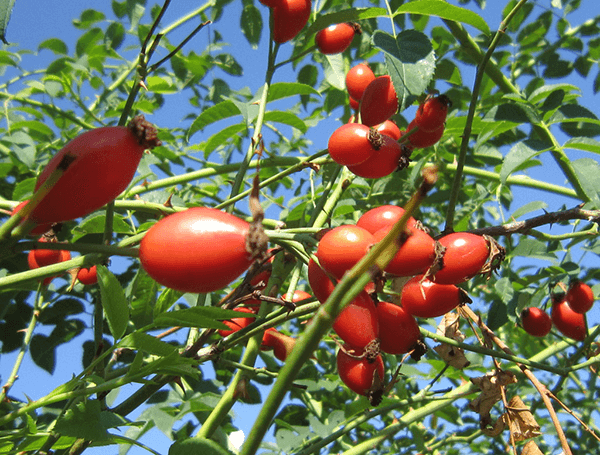Izradu internetske stranice sufinancirala je Europska unija u okviru operativnog programa Konkurentnost i kohezija iz Europskog fonda za regionalni razvoj.
saznajte više
Plant description:
Rose hips are the edible and nutritious fruit of the beautiful deciduous rose, a perennial member of the most extensive genus of classified plants. Most species of rose grow as an upright shrub or a climbing vine. Wild roses often grow in thorny thickets or briers. The usually pinnate leaves are arranged alternately along the stems with two to four pairs of finely toothed, dark-green, oval leaflets and one terminal leaflet. The large blossoms of wild roses have five petals. They grow singly on the stem or in clusters of two or three. Cultivated varieties may have many more petals with colors as varied as white, yellow, pink, and many shades of red. A rose’s true fruits are the numerous tiny achenes, each enclosing a single seed, contained within the hip. Rose hips develop from the stem tip that swells to enclose the hairy achenes.
The smooth skin of the hip is first green, then turns shades of orange and, when fully ripe, a deep red.
Habitat:
Wild rose grows in shady, moist areas such as stream banks and mixed evergreen forests.
Pharmaceutical use:
Minerals, vitamins, essential nutrients and organic compounds are found in Rose hips provides a powerful punch. It also include vital components such as Vitamin A, C, E, B-complex and minerals such as iron, calcium, manganese, selenium, phosphorus, magnesium, silicon, sulfur and zinc. Moreover, it contains organic compounds such as pectin, lycopene, beta carotene and lutein which are essential for the body. Rose hips is able to lower the symptoms of rheumatoid arthritis, prevent cancer, relieve respiratory, lower cholesterol, increase urination,
manage diabetes, boost immune system, build stronger bones and promote circulation. Rose hip could delay digestion of starch which follows carbohydrate consumption of dense meal. The infusion of Rose hip is helpful to control diabetes. Research was made to identify the biochemical compounds found in Rose hip fruits. It was reported that Rose hip fruit contains high content of ascorbic acid, flavonoid and phenolic content, anticarcinogenic, antimutagenic and antioxidant activities. The study was conducted for evaluating main phytochemicals such as total polyphenols, vitamin C and total flavonoids content and antioxidant activity. The content of Vitamin C fruit varies according to the altitude and biotype. Antioxidant and polyphenol content are the parameters of quality for rosehips for its biological properties.The daily consumption of extract of Rose hip is associated with lowering levels of cholesterol. This fruit might be helpful for obese patients. The people who intake a drink of rose hip powder regularly for six weeks experience significant drop in levels of blood cholesterol by 5 percent.
It could lower the chances of heart problems by 17 percent. It could be used as a secure alternative for anti-cholesterol drugs which might provide some side effects. Rose hips contain a high amount of pectin. Pectin is highly ionic, and can draw and hold environmental toxins, radioactive compounds, and heavy metals, enhancing detoxification after subsequent exposure.
Cautions:
Please be aware that herbs, although natural can interact with certain medications, and that they may be ill advised to use under certain health conditions. Please consult a qualified health practitioner for cautions pertinent to you.
No therapeutic claim is made or intended for AZENA products. Information is for educational purposes only.





